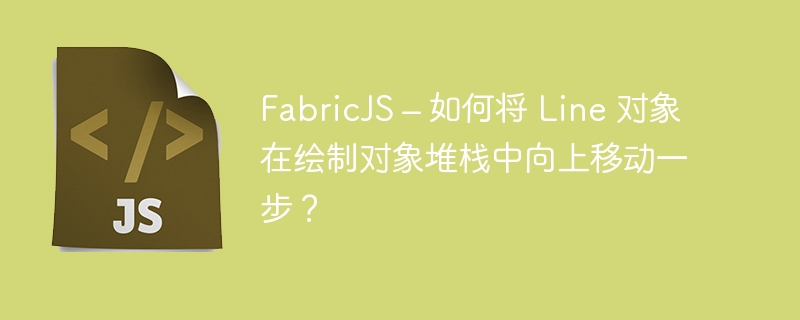
在本教程中,我们将学习如何使用 FabricJS 将 Line 对象在绘制对象堆栈中向上移动一步。 Line 元素是 FabricJS 中提供的基本元素之一。它用于创建直线。由于线元素在几何上是一维的并且不包含内部,因此它们永远不会被填充。我们可以通过创建 fabric.Line 的实例来创建线条对象,指定线条的 x 和 y 坐标并将其添加到画布中。为了将 Line 对象在绘制对象堆栈中向上移动一步,我们使用 bringForward 方法。
bringForward(intersecting: Boolean): fabric.Object
Intersecting - 此参数接受一个 Boolean 值,当分配一个“true”值时,将对象发送到前面下一个上部相交对象。如果值为“false”,它通常会将对象向上发送到堆栈中的下一个对象。该参数是可选的。
让我们看一个代码示例,看看使用 bringForward 方法时的输出。 bringForward 方法将对象在绘制对象堆栈中向上移动一步。在本例中,使用 bringForward 方法将 line1 发送到 line2 之上。
<!DOCTYPE html>
<html>
<head>
<!-- Adding the Fabric JS Library-->
<script src="https://cdnjs.cloudflare.com/ajax/libs/fabric.js/510/fabric.min.js"></script>
</head>
<body>
<h2>Using bringForward method</h2>
<p>
You can see that line1 (blue) has been moved up in the stack of drawn objects
</p>
<canvas id="canvas"></canvas>
<script>
// Initiate a canvas instance
var canvas = new fabric.Canvas("canvas");
canvas.setWidth(document.body.scrollWidth);
canvas.setHeight(250);
// Initiate a Line object
var line1 = new fabric.Line([200, 100, 100, 40], {
stroke: "blue",
strokeWidth: 20,
});
// Initiate another Line object
var line2 = new fabric.Line([200, 70, 70, 40], {
stroke: "red",
strokeWidth: 20,
});
// Add both to the canvas
canvas.add(line1);
canvas.add(line2);
// Using bringForward method
line1.bringForward();
</script>
</body>
</html>
在此示例中,我们使用了三个线条对象,即line1、line2 和line3。尽管它们已按照数字顺序添加到画布中,但 line1 明显位于 line3 之上。这是因为我们使用了启用了交集键的 bringForward 方法,该方法将 line1 发送到其下一个上部相交对象(即 line3)的顶部。
<!DOCTYPE html>
<html>
<head>
<!-- Adding the Fabric JS Library-->
<script src="https://cdnjs.cloudflare.com/ajax/libs/fabric.js/510/fabric.min.js"></script>
</head>
<body>
<h2>Using bringForward method with three objects and intersection key enabled</h2>
<p>
You can see that the blue line now lies above the green line which is line number 3
</p>
<canvas id="canvas"></canvas>
<script>
// Initiate a canvas instance
var canvas = new fabric.Canvas("canvas");
canvas.setWidth(document.body.scrollWidth);
canvas.setHeight(250);
// Initiate a Line object
var line1 = new fabric.Line([200, 100, 100, 40], {
stroke: "blue",
strokeWidth: 20,
});
// Initiate another Line object
var line2 = new fabric.Line([500, 70, 400, 40], {
stroke: "red",
strokeWidth: 20,
});
// Initiate another Line object
var line3 = new fabric.Line([200, 30, 30, 90], {
stroke: "green",
strokeWidth: 20,
});
// Add them all to the canvas
canvas.add(line1);
canvas.add(line2);
canvas.add(line3);
// Using bringForward method
line1.bringForward(true);
</script>
</body>
</html>
以上就是FabricJS – 如何将 Line 对象在绘制对象堆栈中向上移动一步?的详细内容,更多请关注php中文网其它相关文章!

每个人都需要一台速度更快、更稳定的 PC。随着时间的推移,垃圾文件、旧注册表数据和不必要的后台进程会占用资源并降低性能。幸运的是,许多工具可以让 Windows 保持平稳运行。

Copyright 2014-2025 https://www.php.cn/ All Rights Reserved | php.cn | 湘ICP备2023035733号